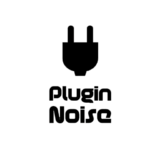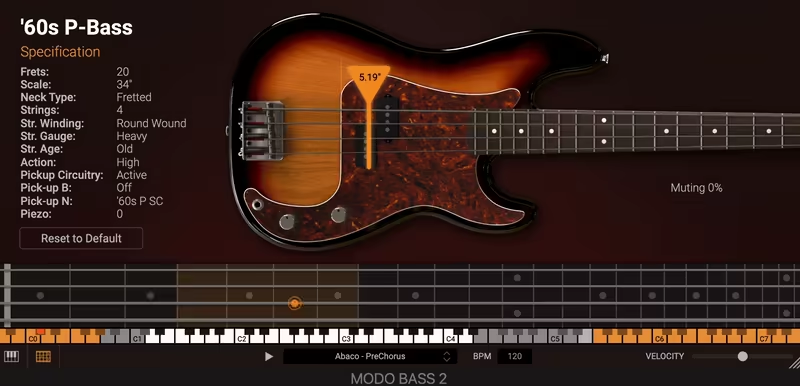MODO Bass 2 offers stunning realism and versatility with 22 bass models, customizable tones, and lifelike physical modeling. Perfect for pro producers, it’s a powerhouse for crafting dynamic, genre-spanning basslines, despite minor system demands and a premium price.
Pros
- Realistic physical modeling creates lifelike bass tones
- Extensive customization options, from strings to pickups
- 22 virtual bass models, including fretless and upright
- Built-in effects and amps for versatile tones
- Lightweight plugin with a small storage footprint
Cons
- Occasional stuttering on less powerful systems
- Limited amp options compared to other virtual bass tools
- Higher price point may be too much for casual users
Today, we’re shining the spotlight on MODO Bass 2 because it’s about time the bass stopped being the “quiet one” in the band and got the attention it truly deserves.
Good news, bass players! Today, we will talk about bass (which is rarely the case in the music world), but about a plugin that will probably take your jobs away: Modo Bass 2. Jokes aside, basslines are the heartbeat of most genres. Be it the smooth grooves of R&B or the gritty thump of punk rock, music can’t be music without them.
As it’s not possible to have a bass player sitting around all the time or not everybody has the skill to nail those intricate, genre-perfect lines, IK Multimedia created the Modo Bass 2 with real-time physical modeling and an expanded library of 22 meticulously crafted virtual basses.
From fretless to upright bass models, this plugin is highly customizable, offering a realistic solution for producers and musicians to create pro-level basslines without the need for a bassist.
Can this plugin really replace a real bass or a bassist? What are the features, and how are the usability, sound quality, and character? These are the questions we will chase today to see if this plugin can be the ultimate tool for your low-end arsenal.
Well, spoiler alert: you might wanna take a new direction in your career, bass players, as this plugin is a whole vibe!
| Feature | Details |
| Bass Models | 22 virtual basses, including 8 new models (fretless and upright basses). |
| Physical Modeling | Real-time synthesis recreates string, fretboard, and pickup interactions for lifelike sound. |
| Play Styles | Finger, Pick, Slap, and Mute styles with customizable parameters (touch weight, muting, etc.). |
| Patterns Browser | Over 1,000 MIDI bassline patterns organized by genre, song section, and play style. |
| Customization | Adjustable string type, pickup placement, fretboard age, and more for personalized tones. |
| Effects and Amps | 7 stompbox effects (e.g., Distortion, Compression, Chorus) and 2 amp models via AmpliTube. |
| Studio Controls | Upright bass mic placement, piezo signal blending, and stereo room mic adjustments. |
| Compatibility | Works on Mac and Windows; supports VST2, VST3, AU, AAX formats; lightweight 200MB install. |
Features
IK Multimedia made some serious upgrades in the second version of the powerful bass VST. They enhanced the realism and added new features for further customization and control over the sound.
Let’s explore the core features that make MODO Bass 2 stand out.
- 22 Virtual Basses
At the core of MODO Bass 2 lies the extensive library of 22 virtual bass models, including 8 new additions.
This collection caters to nearly every genre, with a wide range of instruments from iconic electric basses to fretless and upright options.
The standout newcomers include fretless models inspired by legends like Jaco Pastorius and two upright basses designed for jazz and acoustic tracks. Each bass is crafted with painstaking attention to detail, delivering a rich, lifelike sound.
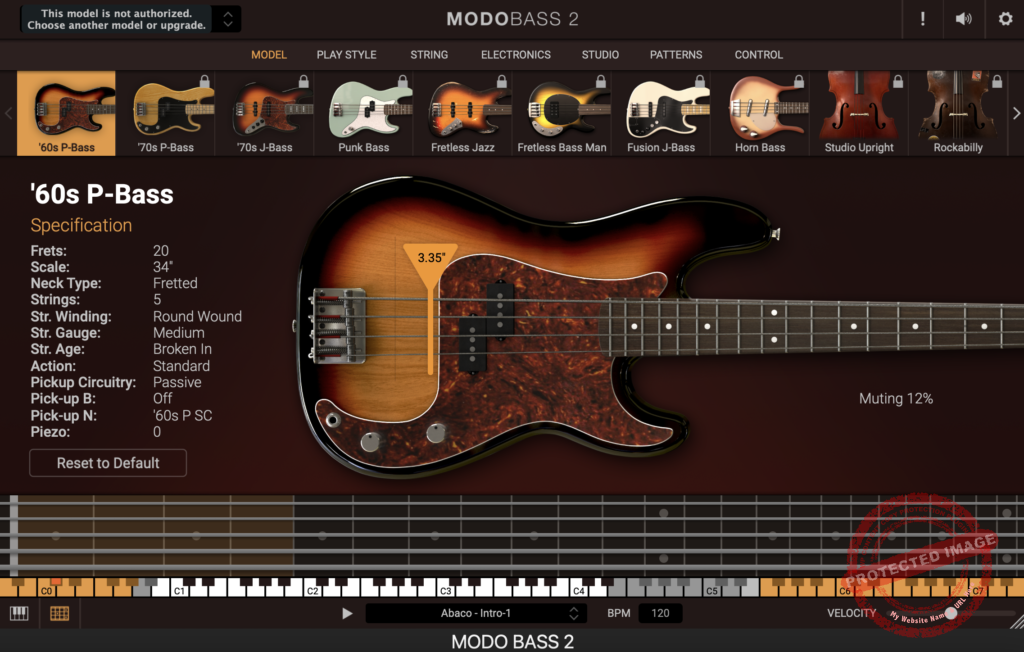
- Real-Time Physical Modeling
Unlike sample-based instruments, MODO Bass 2 uses real-time physical modeling, simulating how strings interact with frets, pickups, and the bass body.
This approach allows for dynamic performances and tonal flexibility that sample-based plugins just can’t match.

- Expanded Play Styles
MODO Bass 2 offers play styles for every situation: Finger, Pick, Slap, and Mute. Each style is fully adjustable, with parameters like muting intensity, picking technique, and even touch weight. I loved this amount of control as it gives you the ability to create super realistic low-end textures.
Also, this level of control ensures your bassline fits perfectly with the track’s vibe, whether it’s a mellow ballad or a funky slap groove.

- Patterns Browser
The redesigned Patterns browser features over 1,000 MIDI bassline patterns organized by genre, section, and style.
When you need inspiration, you can simply drag and drop a pattern into your DAW, and you’ve got a starting point for your rhythm section. It’s an instant productivity booster that takes the guesswork out of building grooves.

- Deep Customization
MODO Bass 2 lets you customize every detail of your virtual bass, including string type, pickup configuration, and even fretboard age, which gives you even more control to shape your sound and increase realism.
You can create super precise instruments like a fretless 5-string with flat-wound strings and a custom pickup arrangement. The ability to tweak everything down to the last detail is a dream for tone chasers.
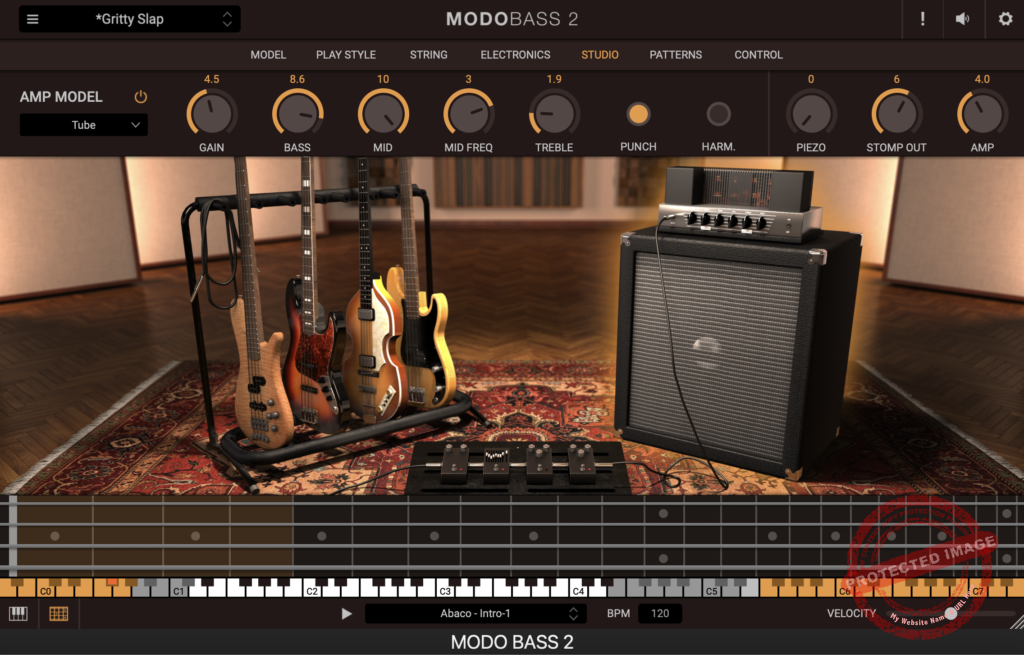
- Effects and Amps
With 7 stompbox effects, including Octaver, Distortion, Chorus, Compressor, Delay, and Envelope Filte,r along with 2 amp models, you can shape your tone to your desire.
The amp choices are an all-tube amp with a 1×15 cab and a solid-state model with a 4×10 cab, taken from Amplitube tech. Plus, it allows you to finetune your amp with gain structure with EQ and graphic EQ.
Whether you’re after warm vintage vibes or gritty, modern punch, MODO Bass 2’s onboard effects deliver.
Interface and Workflow
Besides the sonic quality, I really like the smooth and enjoyable workflow IK Multimedia brought to the table with this plugin. The interface is clean, intuitive, and packed with visual tools to help you tweak every aspect of your bass sound.
Interface
To start with, the resizable GUI is pretty colorful and realistic, with different tabs for each step of the workflow: Model, Play Style, Strings, Electronics, Studio, Patterns, and Control. As each tab has a specific responsibility and purpose, it is well-organized, and you are always a click away from the features you need.
I liked the virtual fretboard and keyboard at the bottom, as they provide a nice visual representation of the note placements and articulations. It is kind of like a real bassist performing as you work, while the color-coded section indicates key switches and playable notes, which are pretty handy for MIDI programming. You realize how handy this design is, especially when working on complex projects.
Another thing to highlight is the Patterns Browser, which has a seamless integration into the interface. It is really easy to audition and drag patterns, which relaxes and quickens the process while searching for the perfect groove.
Lastly, I wanna say the responsive interface feels really good as you hear the adjustments immediately, which opens the doors of experimentation without distracting you from your workflow. The combination of sleek visuals and functional design makes it a pleasure to use.
I think the GUI is a good blend of simplicity and depth, making it suitable for every producer from beginner to pro.
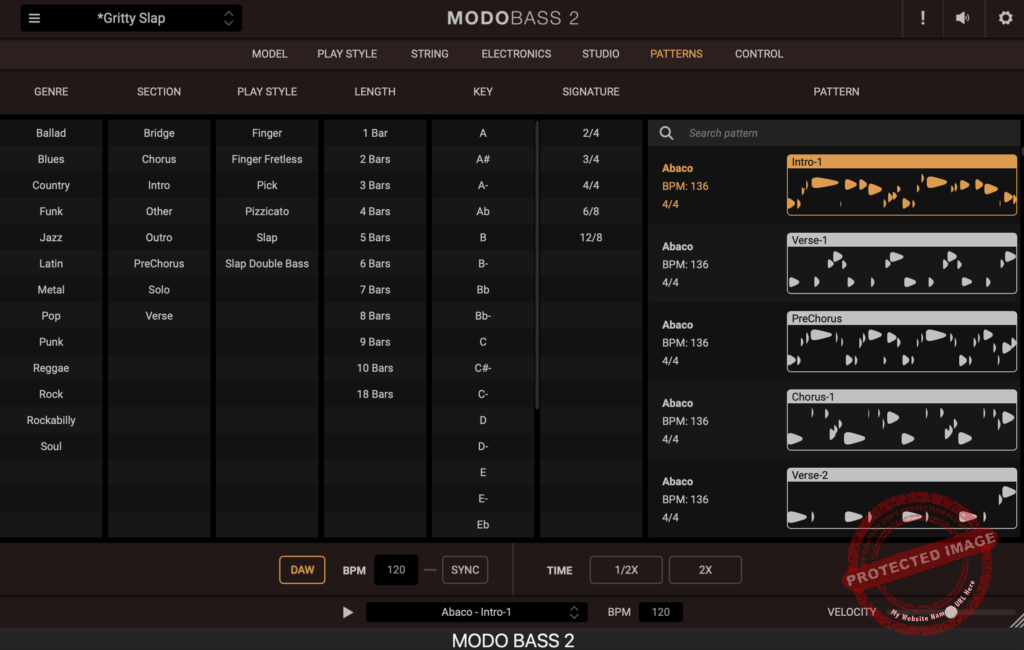
Workflow
Coming to the workflow, using MODO Bass 2 is surprisingly straightforward, given the sheer number of features.
For quick results, you can select a bass model, tweak a few presets, and start playing. But for the tinkerers out there (you know who you are), the plugin offers endless customization possibilities.
First, you get the ability to switch play styles and adjust parameters like muting and touch weight in real time. I love this as it increases the realism of the bass grooves and makes it feel less like a plugin and more like a creative tool. For instance, you can switch to Slap mode if you have a funky track and adjust the mutings for more tightness and percussiveness in seconds.
In my opinion, the real-time MIDI control is the highlight of the workflow. Mapping key switches or automating parameters like slides, bends, and vibrato has the potential to give you pretty dynamic performances.
The workflow is well-organized and streamlined with tabs for each step, which makes even the complex setups feel intuitive. You can easily tweak mic placements for the upright bass or customize a fretless model; everything is designed to keep you in the creative zone.
First Impressions and Sound
As you may have noticed by now, I am pretty impressed with the MODO Bass 2 and the realism it provides. Each bass model, from the classic P-Bass to the Rockabilly Upright, feels authentic and alive.
My favorites are the fretless models, as they give great smoothness and expressiveness, which I rarely see in sample plugins. I loved sliding between notes and adding subtle vibratos here and there, as they sounded natural, adding emotion to the tracks.
Another plus to mention is the unit’s adaptability. For jazz, the Studio Upright model provides warmth and depth, while for funk, the Fretless Jazz in Slap mode gives tight and snappy tones that suit the genre perfectly.

So, you are not really limited to one genre with this unit. You can switch from Finger style to Mute within the same part to add a more dynamic, human feel to the track.
When I tweaked some controls like pickup position, string type, or effects to try out, the bass sounds responded really well. It makes you feel like you have an entire rig in your DAW.
The effects sound pretty good, especially for rock tracks. Adding compression and distortion, you can get some gritty, aggressive tones.
The only thing I would have liked to see would be more amp models to play with, as only two models are a bit limiting. Also, on the dark side, I have to mention that I experienced occasional stuttering when switching models on, but I guess this vanishes with more RAM power.
Overall, my impression is that MODO Bass 2 sets a new standard for virtual bass instruments, combining realism with versatility. It’s a must-have for producers looking to craft lifelike and dynamic basslines.
Compatibility
MODO Bass 2 runs on both Mac (Intel and Apple M1) and Windows systems, supporting VST2, VST3, AU, and AAX formats.
It’s lightweight (around 200MB), but for the best performance, IK recommends at least 8GB of RAM. But, to prevent the occasional stuttering, I would suggest at least 16 GB of RAM.
Last Words
MODO Bass 2 is a comprehensive bass solution for any producer or musician. I was already a fan of the first version, and with the new tones and stylistic options, as well as the addition of two lovely fretless electric basses and two upright basses, this one makes the most lasting impression.
Whether you’re creating intricate funk grooves or simple rock lines, this plugin delivers stunning realism and unmatched flexibility. While a bit pricey, its depth and quality make it worth the investment for serious producers. I can honestly say MODO Bass2 will make virtual session players happy for a long while.

Berk Öztuna, a musician from Istanbul, is skilled in handpan, percussion, and guitar, performing and recording his own compositions globally. With expertise in music production and audio technology, he integrates virtual instruments and sound design tools seamlessly into his work. He also writes insightful articles on music production and gear for platforms like Plugin Noise and shares his music on Spotify and Instagram.
DONATE: Love our content? Help us keep Plugin Noise alive in the age of AI — Your donation fuels better content for music creators like you! You can donate here: pluginoise@gmail.com (Every amount counts.)
